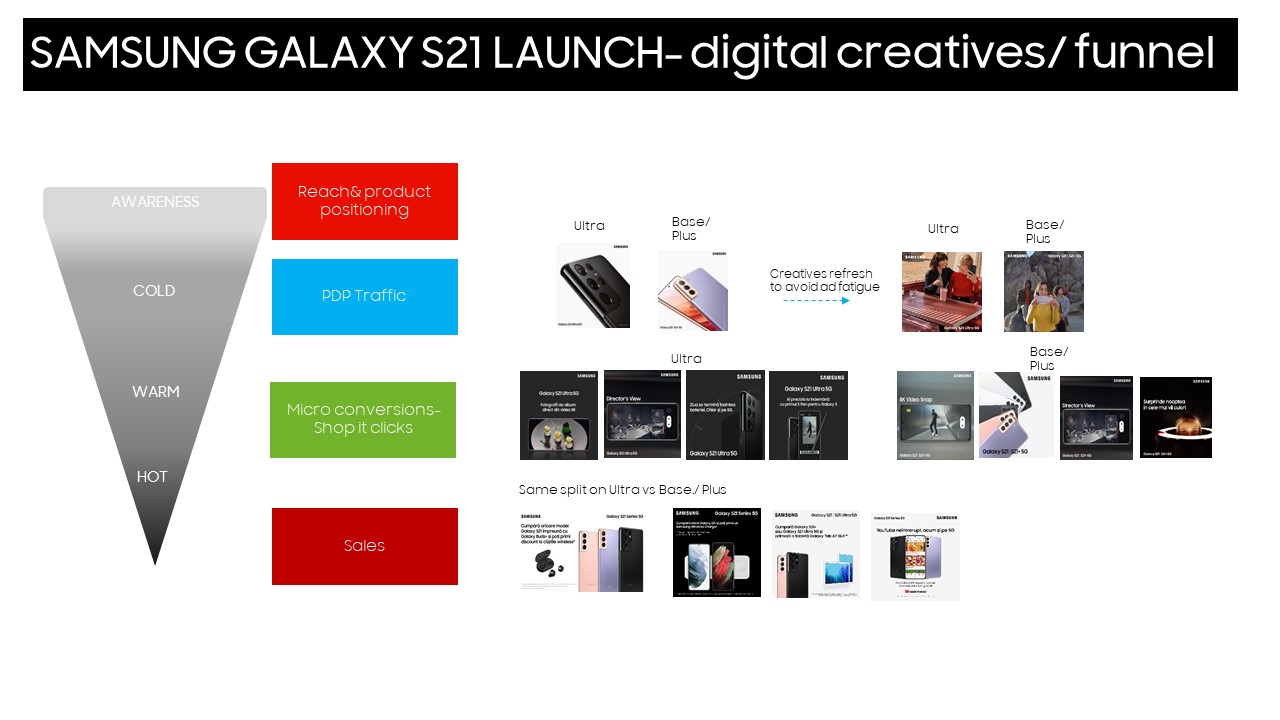Campanie
General Information:
Strategic approach:
| Strategic approach: |
CONTEXT For Samsung, Galaxy S series smartphone is the most important launch of the year that sets the tone for the entire portfolio performance. But in 2021, more than ever, we needed to pay a closer attention to the context. Consumers are disengaged with the category and this became more pronounced due to pandemics (tend to postpone purchases that aren’t necessary, are less excited about novelties in tech). The S20 product (the previous model, before S21) performance was under S10, as proven by brand KPI: awareness (38% vs 58%), consideration (24% vs 34%). Competition is getting harsher, as the media investment in the category is increasing, with more mid-range competitors gaining ground. CHALLENGE Online shopping increased during pandemic, which led to higher focus on Direct to Consumer as sales channel, so this launch was expected to significantly increase share of sales to DTC among all sales channels. However, Google Trends data shows that with every new launch, the level of flagship model queries is lower, which impacts the delivery potential for ecommerce demand capture channels, where intent is expressed (as search is). This places a higher pressure to profile users more likely to buy and find them on discovery commerce channels, such as social media. OBJECTIVE With this launch we had to deliver a YOY growth of DTC: increase online sales from own e-shop x 4 versus previous flagship. The target was this ambitious as the starting base was not large- the sales from 2020 were impacted by the lockdown as it was launched in March 2021. Moreover, this was the first campaign with DTC first focus, more than ever. APPROACH We used Samsung’s ecosystem of first-party data to identify audiences with highest propensity to buy and coordinate our media strategy to reach these audiences across major media platforms based on priority ranking. 1. Facebook Machine Learning Based Targeting to seed Samsung 1st party data towards Facebook algorithm Facebook customer data on S series and N series purchaser used in a prediction model that builds a decision tree accurately identify purchaser, based on variables as device model, age, service usage, etc. 50 features were scored in terms of importance to build three predicted audiences that were utilized: • Upgrade soon: Reach customers are the most likely to upgrade in next 2 months • Acquire soon: Reach customers are the most likely to be acquired to N20 in next 2 months (Device acquisition) • Churn soon: Reach customers are the most likely to churn in next 2 months 2. Device & funnel position audiences with Adobe Audience Manager DMP to address own & competitive users’ pain points with relevant product features Data Management Platform signals (data) were used to build audiences based on device ownership (Samsung, iPhone, Other Android) and funnel stage (Cold, Warm, Hot). 3. Leverage Samsung CRM data to profile users based on their propensity to buy Samsung’s custom propensity scores assigned 1st party audiences to different stages of the consumer journey funnel based on likelihood to convert. The profiling strategy has been defined based on 3 types of dimensions: email engagement (engaged, unengaged), S-score propensity deciles (for funneling of the audiences) and Device purchase history (for exclusion of recent product registrations). |
Execution:
| Images: |

|
| Video Link: |

